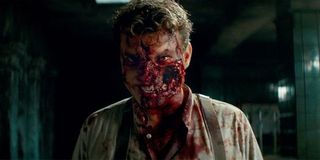Why Overlord’s Director ‘Selfishly’ Used Practical Effects Over Visual Effects

Thanks to the progression of computer-aided digital effects, there's essentially nothing that you can't create in the movies today. However, while one might assume that such effects were used potentially excessively in order to create the Nazi zombie's of Overlord, it turns out that whenever possible, director Julius Avery used practical effects and prosthetics. He, along with actor Pilou Asbaek spoke to CinemaBlend's own Eric Eisenberg recently and spoke about his "selfish" decision to use more practical effects, because it made his job easier capturing performances while also keeping the movie grounded, to a degree. According to Avery...
For me it was just about, how can I keep it in reality and keep it as practical as possible. I'm selfish that way. I like the actors to be behind the prosthetics and, for me, if it went too far and too outlandish it would too fantastical. And also, just selfishly again, I can get a good performance with a whole bunch of, like, weird stuff hanging off you. You start looking like the blob.
While the premise of Overlord is certainly fantastical, iIt's clear that Julies Avery wanted to make the movie feel as realistic as possible. As impressive as most CGI is, often it still looks animated to a degree and not like it exists in the same world as reality. While that's usually fine for your average comic book superhero movie that is meant to look larger than life, it's not what the director wanted here.
For many directors, digital effects might seem like the more selfish option. It's all done in post-production meaning that you don't have to wait for actors to spend hours in makeup chairs in order to look the way you need. However, Julius Avery says he really wanted to be sure that the actors were behind the performances that were given, even if those performances were behind significant prosthetics. It's easier to get a performance from somebody who's supposed to be playing a monster when they actually look like a monster.
Pilou Asbaek, who plays one of those roles that required hours in the makeup chain only supported Julius Avery's statements. While he admitted getting the prosthetics done was a pain, he felt it was the effort once filming began.
Julus is absolutely right. It sucks sitting in makeup for five hours, but you know what, when you see the result, it's worth it. And it's basically, when you see the result you can give to your colleagues, it's 1000% worth it, because they can react. There's nothing more boring than CGI and green screens, it's the worst.
While it's understandable that an actor might feel more "in character" themselves thanks to prosthetics, the way that it impacts the other actors can't be ignored. When you're using digital effects an actor has to imagine whatever it is they're supposed to be seeing but if they can actually see it, of course, it's going to improve things for everybody involved.
Overlord is in theaters now. Check out the full conversation about the value of prosthetics in the video below.
CINEMABLEND NEWSLETTER
Your Daily Blend of Entertainment News

CinemaBlend’s resident theme park junkie and amateur Disney historian, Dirk began writing for CinemaBlend as a freelancer in 2015 before joining the site full-time in 2018. He has previously held positions as a Staff Writer and Games Editor, but has more recently transformed his true passion into his job as the head of the site's Theme Park section. He has previously done freelance work for various gaming and technology sites. Prior to starting his second career as a writer he worked for 12 years in sales for various companies within the consumer electronics industry. He has a degree in political science from the University of California, Davis. Is an armchair Imagineer, Epcot Stan, Future Club 33 Member.
Most Popular







